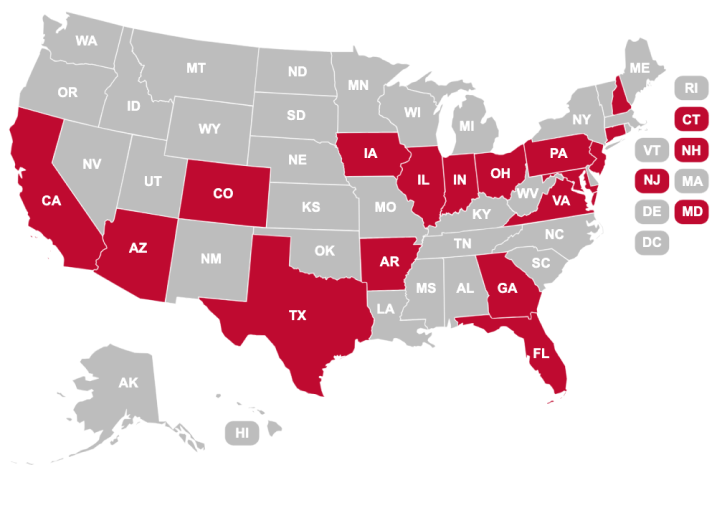403b vs 457b Plan. Which One Should You Choose?

h2
403b vs 457b plan – what’s the difference and which one is better? Well, if you want to build your ideal post-retirement life, you must have your finances sorted. And for that, you need to have a well-rounded retirement plan. Moreover, employees working in government as well as non-profit organizations are now offered several employer-sponsored, tax-advantaged retirement plans, such as 403b and 457b, etc. Furthermore, these plans provide employees with the retirement funds they need to secure financial stability after they have stopped working. Want to know more about these retirement plans? Here is your guide on everything you should know about 457b vs 403b.
- Public sector companies and non-profit organizations provide their employees with tax-advantaged plans including 403(b) and 457(b).
- Both plans have a $23,000 limit for 2024, with $7,500 catch-up; 457b allows up to $46,000 near retirement.
- 403b requires 59½ for penalty-free withdrawals, with 10% early penalty; 457b has no penalty for job leavers.
- 403b offers tax benefits and catch-up contributions but has early withdrawal penalties; 457b has tax benefits and flexibility.
403b Plan vs 457b Plan. Your Comprehensive Guide
As aforementioned, 403b and 457b are the two retirement plans offered to government and non-profit employees. Both of these plans are quite beneficial in helping employees gather adequate funds for a financially peaceful retirement life. Moreover, you should know that both of these retirement plans are highly efficient but both of these differ from each other in certain ways. Having a know-how about the eligibility, aspects, benefits and more of these plans will give you a clear idea of what to expect and how to plan ahead. Therefore, we are here to help you! Here is a comprehensive guide – comparison – of 403b vs 457b retirement plans. Let’s get started!
What is a 403b Plan?
Before discussing 403b vs 457b, you should about both plans in detail. Let’s begin with the 403(b) plan. It is a tax-advantaged retirement plan offered by non-profit employers. When you sign up for this plan, a specific amount deducts from your paycheck. Furthermore, you get to save and grow these funds without worrying about taxes. Yes, that’s right! This plan is tax-deferred or tax-free.
“403(b) is a tax-benefited retirement plan that allows its participants to save for retirement through payroll deductions while availing of certain tax benefits.” – Investopedia
Hence, this can be your way forward to ensure peace of mind regarding financial planning. Besides, you should know that public schools and non-profit organizations offer this plan to their employees. You may be wondering who is eligible for this retirement plan. Well, these plans are mostly used by educational institutions. However, any entity that complies with IRS Section 501(c)(3) can adopt it. Besides, the participants can be:
- Employees of public schools, state colleges, and universities
- Indian tribal government public school employees
- Employees of tax-exempt organizations
- Ministers and clergy members
- Church employees
These may include teachers, professors, nurses, doctors, librarians, or anyone who works in these organizations. These are the employees who can benefit from this plan and save up a decent amount for a peaceful retirement.
What are the Types of 403(b) Plan?
Before comparing 403b vs 457b, we are on our way to thoroughly talk about 403(b) plan. You should also know that this plan has two types. And both of these offer different benefits to their participants. Moreover, these types are: traditional 403(b) and Roth 403(b) plans. If you are interested in knowing more about these types (what they offer and how they differ from each other), here is a comprehensive comparison for you:
Hence both plans have their own perks and downsides. Additionally, you should know that not all employees can access the Roth plan. Apart from this, the traditional version offers immediate tax benefits but there are no immediate benefits in the latter one. But really you should go with the version that makes your retirement planning more efficient and stress-free.
403(b) Plan – What are its Contribution Limits?
As you know by now, 403b plans allow its participants to save for retirement and grow their investments while enjoying several tax benefits. Moreover, this plan is regulated on the basis of certain contribution limits which became similar to that of 401k plans.
According to the Internal Revenue Service, here are the 2024 contribution limits of the 403b plan:
- For 2024, the annual contribution limit is $23000
- Individuals over 50 can contribute around $7500 as a catch-up contribution
- Employees with 15-year tenure can make an extra $3000 catch-up each year
- The above 15-year rule has a lifetime limit of $15000 per employer
However, there is another option that lets employers make matching contributions based on the limits of the Internal Revenue Service – which allows the overall employee-employer contributions of $69000. Moreover, according to the updated plans, the employee must be 591/2 years of age to withdraw these retirement funds. Or else they may have to pay the early withdrawal penalty.
403(b) Plan – What are the Distribution Criteria?
As mentioned before, 403b and 401k plans are quite similar in terms of certain regulations. This also includes the distribution rules. Moreover, the relevant authorities separately mail these rules and regulations to the participants every year:
- You have to be at least 591/2 years old to withdraw money
- Apart from special cases, early withdrawals are subject to a 10% penalty
- The tax on other normal distributions is similar to the regular income
- Those who have a Roth plan or Roth IRA can enjoy tax-free distributions
- Those who turned 73 in 2023 can begin with Required Minimum Distributions (RMDs)
- If you fail to take the required minimum distribution, you pay a 25% excise tax on that RMD amount
- Effective 2024, the participants will be able to withdraw $1000 annually for emergency expenses.
- Loan provision rules are also similar to 401k plans. Participants can only take up to the lesser of $50,000 or half of their plan’s total amount.
With a thorough know-how of these regulations, you are all set to make informed decisions regarding your retirement finances and investment planning. You can assess how to manage several expenses, savings, and emergencies during your retirement – easily so! While we are on our 403b vs 457b quest, you should know about the latter plan too. Let’s discuss what it holds for you.
What is a 457b Plan?
Want to know who takes the score in 403b vs 457b? Well, for that you should first know what is 457(b) plan. Just like 403(b), this one is also a tax-advantaged plan. The participants of this plan get to take out some amount from their salaries without being taxed. Instead, they pay regular income taxes on your regular withdrawals. Besides, the employees – the participants – have the freedom to choose where to invest this amount. This mostly includes mutual funds and annuities.
“The employees can even contribute a 100% of their salaries to the 457(b) plan. However, it should not exceed the dollar limit set for the year.” – Internal Revenue Service
You should know that the 457(b) plan is one of the types of 457 plans. These plans are of two types and the other one is 457(f).
Quick Question: What is the 457(f) Plan?
457(f) is one of the two types of 457 plans. Although both plans specifically benefit the government and non-profit employees, this one is for highly compensated executives. Furthermore, this plan is also called SERP (Supplemental Executive Retirement Plan). After all, it’s a supplement to 457(b). This plan allows the employer to make more contributions to the employer’s account than usual.
You may be wondering what makes you eligible for a 457(b) plan. Well, here is a list of participants who are eligible to sign up and avail of the benefits of this plan:
- Civil servants
- Police personnel
- Employees of Government agencies
- Employees of public service & non-profit organizations
This list also includes firefighters, paramedics, municipal employees as well as public school teachers. Additionally, keep in mind that this plan is not for top-level executives at these institutes. Instead, they are subjected to 457(f).
457(b) Plan – What are its Contribution Limits?
For the next step in our quest of the 457b vs. 403b quest, we are discussing the contribution limits of 457b. Moreover, the IRS sets these limits and the participants have to abide by them. For the year 2024, these include:
- The contribution limit for employees increased from $22500 to $23000 for 2024
- You can also contribute all of your income if it's less than the set limit
- The catch-up contributions for the tax year 2024 is $7500, increasing the max limit to $30500
- Double-limit catch-up provisions allow participants within 3 years of retirement to contribute up to $46000
457(b) Plan – What are the Distribution Rules?
We have discussed the contribution limits of the 457b plan. But do you know what benefits it offers for during the withdrawal stages? Well, let’s find out together. The best thing that makes these plans more considerable as compared to 403b or 401k are as follows:
- The withdrawal age for this plan is also 591/2
- Individuals don’t have to pay an early withdrawal fine on leaving a job
- Although there is no penalty, you still have to pay regular income tax in the above case
The no-early withdrawal penalty removes a lot of stress from informed decision-making. After all, it saves you from paying out a big chunk of fines. And you get to keep it for yourself. As a result, you get to grow and mature with the right amount of money you need to build your ideal lifestyle.
403b vs 457b. How are they Different from Each Other?
Now that we have thoroughly discussed each plan in detail, it's now time to come to the main topic for which we are here: which one is better 403b vs 457b? As you already know that both of these offer specific set of benefits. Both are tax-advantaged and both let you save up to build your ideal lifestyle. Moreover, both of these plans are for government and non-profit employees. So, what is it that makes 403b vs 457b different from each other? And which one is a better option? Well, for this, let’s discuss what benefits each of these offer:
What are the Perks of 403(b) Plan?
While we are on our 403b vs 457b quest, we should know what the benefits of each plan are. After all, the benefits are what we are here for. Moreover, the biggest benefit of this plan is that it sets you off for a stress-free retirement. Other than this, these plans offer several perks for contributions and distributions.
What are the Disadvantages of 403(b) Plan?
403(b) surely comes with some prominent perks. But this plan has some disadvantages too. Let’s talk about them below:
What are the Perks of the 457(b) Plan?
Now that we know what benefits 403(b) provides, we should also know what the other one has to offer. Offering a different set of perks, 457b also promises a stress-free retirement. The following are some of the reasons why you can go for this retirement plan:
What are the Disadvantages of 457(b)?
Every retirement plan comes with its own set of advantages. However, you should know that downsides always accompany perks. Here are a few disadvantages of 457(b):
A Comparison Chart of 403b vs 457b Plans
We have discussed all the pros and cons these plans come with. You can assess them and decide for yourself what’s better for you. Or else you can have a look at the comparison chart of 403b vs 457b below:
403b vs 457b – Which Plan is Better?
Now that you know about the benefits, downsides, elements, contributions, and distribution rules of both the plans, you can make the right choice for yourself. Thinking which one among 403b vs 457b is better? Well, this depends on your financial situation, future goals, and needs. Assess what you want and then make a choice. So, choose wisely; after all, your choice is going to impact your future – big time. If you think you need assistance making this decision, you can contact a professional retirement planning specialist. They how to navigate the retirement complexities and will offer well-rounded advice.
Quick Question: 403b vs 457b – Can You Contribute to Both?
Well, yes! You can contribute to both plans at once. But is this a good decision? Well, to assess whether this is a good idea or not, you should contact a professional consultant. He will assess your situation and provide you with the insights you need to choose what’s right for you. Moreover, if you sign up for both, you have to completely follow the IRS limits for both.
Ending Thoughts on 403b vs 457b!
If you have come here reading, you are completely aware of what both 403b and 457 plans have to offer. Moreover, these plans are no less than good news for government and non-profit employees. It’s like a reward for their years of grinding themselves in hard work. Besides, it’s their key to establishing the lifestyle you want to lead for yourself and your loved ones. To make this process easier, you can explore resources like a 403b calculator or 403b retirement calculator to see how each plan may align with your financial goals.





%20Plan%20Options%20Everything%20You%20Should%20Know.jpg)




.png)
.png)




%20Beneficiary%20Everything%20You%20Should%20Know%20as%20a%20State%20Employee.jpg)





